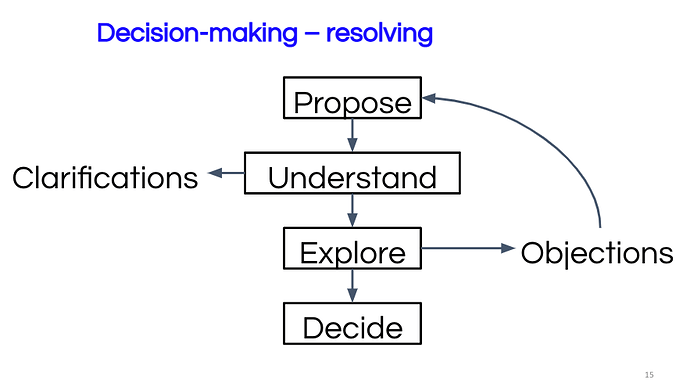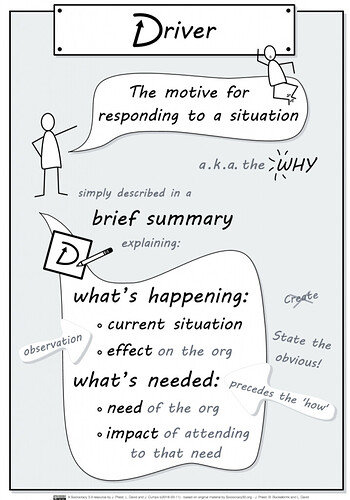Hello! Big topic ![]()
Our pledge says the following:
For the decisions that concern more than one Open Food Network Affiliate, or the broader community, the given process should apply: * Someone opens a thread on [https://community.openfoodnetwork.org/ and share about the situation, the tension, and the proposal he/she asks the community to decide upon. * The person who opens up the thread is in charge of facilitating it and asking specific people to contribute, or can ask someone to facilitate. * In particular, the facilitator needs to make sure the people/partners impacted by the decision are asked to contribute to the discussion. * If a consensus or a consent emerges from the discussion and no one objects, the decision is taken through “lazy consent”. This means that we will assume agreement in the absence of any objection. * If no consent can be reached, then a vote can be called. In that case, every Affiliate has one voice, and a decision requires ⅔ of support to be adopted. [NB. Voices of other Members to be considered on a case by case basis e.g. depending on the issue]
Which I think is a very good base and works in most cases ![]() However as we grow OFN global starts to have more and more decisions to make and we need to go a step further in our decision process to help us take decisions with the least pain. This is why I’m opening this topic: I think there is material to document a bit further our decision process for OFN global.
However as we grow OFN global starts to have more and more decisions to make and we need to go a step further in our decision process to help us take decisions with the least pain. This is why I’m opening this topic: I think there is material to document a bit further our decision process for OFN global.
A few issues I have encounter people saying:
- “we don’t know who are the people impacted by the decision”
- “we are afraid decisions are being made without us”
- “we read discourse posts but at the end we don’t know if a decision has been made”. I heard this one often. I think we do this, but there are a lot of topics where only a few people participate, so they never reach a conclusion. Let’s call this problem the 3bis : “we have unresolved questions”.
- “if a vote needs to happen between people who are not representing instances, how does it work? Who gets a voice, who gets more weight?”
Some ideas on decision involving several circles
I’m dumping ideas here taking into account that we are structuring ourselves in circles. Aside from chats I had with @Thomas this has not been discuss anywhere before if I’m not mistaken - so please consider these as ideas everyone can heavily martyrize.
1: As long as the decision is involving only one circle, this circle can decide on its own how to make that decision and where to store it
(of course we should aim at reducing the numbers of tools we are using but that is another debate ![]() )
)
I’m proposing this in order to simplify a bit the process to start and especially because I think our problem space is more about how to take decisions when several circles are involved.
It’s only solving partially issue number 1, but I feel like it is easier to first ask: should I check my proposal with only my circle or is this more global?
2: if the decision involves several circles, at least 2 people need to facilitate the proposal
I’ve noticed this during the recent Reactive Reals vs React discussion. It was great that Lynne step up to hold the “business” proposal while Matt was facilitating the tech proposal.
Maybe we can build a best practice around this and always find a representative in each circle impacted? The team thus formed would work on a proposal to bring to the global community for final decision.
3: Introducing time frames & deadlines
This was introduced in a presentation @Thomas gave at a global hangout. I’m re-introducing this idea here because I feel we need to anticipate a bit our decisions so we have time to discuss them. This means writing up some rules to give an idea of how long the community has to reach a decision.
Something like:
- no decisions involving several circles can be made in less than 48 hours (to solve issue number 2 I’m even tempted to say a week… also for timezones reasons and for post like the one I’m doing right now on a Friday night
 )
) - In Open Food France & CoopCircuits we organize our decisions timeline like this:
- A post is shared and people can start commenting / asking questions - D
- People are asked to give their opinion starting at D + 8
- A decision is made at D + 16
What do you think? It means that discussions are open during 2 weeks in which people can also make amendments / different proposals. If it is a bigger decision that needs a longer process it can of course be made. It’s just a generic approach.
4: Always conclude something after the deadline
I might be completely naïve, but I’m under the impression that if no decision were made on some topics it was either because there was no rush, either because we had lots of decision at the same time and the facilitator got lost.
I think that in these cases, time frames are helping: after the post is open for 2 weeks we can either left it open for another period of time or take some time to properly document that no decision was made because [reason]. - Hoping this can help on issue number 3.
5: Create a list of handles to ping
I don’t think it’s a good idea to start thinking about tools for decision making process before agreeing on our decision making process ![]() . So in the meantime, in order to help on issue number 1, how about we create a list of handles per circles so that we just need to copy paste these handles in our discourse posts? I’ve also seen that the group feature of discourse can generate handles, but I haven’t dig deeper at this stage.
. So in the meantime, in order to help on issue number 1, how about we create a list of handles per circles so that we just need to copy paste these handles in our discourse posts? I’ve also seen that the group feature of discourse can generate handles, but I haven’t dig deeper at this stage.
And re voting I absolutely have no idea how to define voting, but I agree it is very interesting to define it before needing to vote on something. Indeed votes only occur if we need to reach a decision and no consent is emerging.
For example in France, if we need to use a vote, people working for OFN or using OFN services/softwares have more weight in the voting process than other people. But how to introduce this within OFN global circles? Do we say each circle has 1 voice? And to start, each circle has equivalent weight?
haha I almost feel like I should have made 1 discourse post per idea… I hope this is readable!







 ), please have a look here:
), please have a look here: